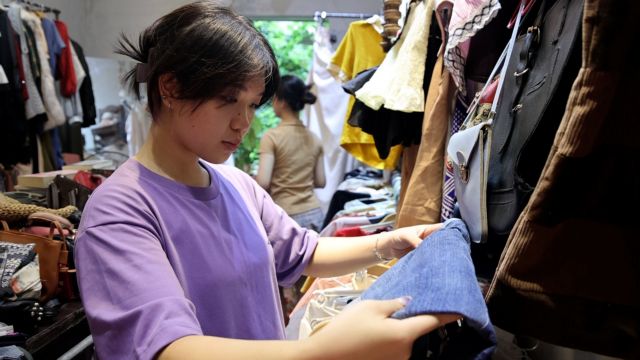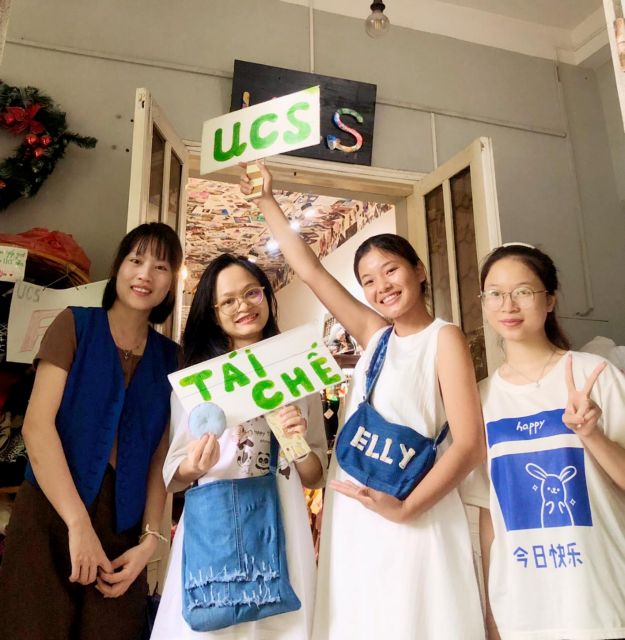 Society
Society

By Minh Phương
HÀ NỘI/HCM City — New season, new styles, buy more, buy cheap, use less then throw it all away... welcome to the world of modern fashion.
The fashion industry is regarded as one of the most wasteful sectors. If you don’t believe this is the case? Check your closet.
Wardrobes around the world are overflowing with tops, skirts, dresses and shirts – many of which have hardly seen the light of day.
The United Nations Environment Programme recently shed light on the fashion industry, and how purchasing habits of individuals is creating far too much waste.
One serious concern is ‘fast fashion’. This means when new designs are released by high-end labels, they quickly enter the mass market at a low cost.
Before you know it, those ‘must-have’ accessories become old hat and before you know it, another cool collection has overtaken your latest purchase in the fashion stakes.
This has led to clothing consumption increasing by 60 per cent over the past 15 years, yet each item has been used only half as long.
All of this waste adds up puts the fashion industry at the front of the line when it comes to unnecessary waste.
Waste not, want not
The concept of ‘circular fashion’ emerged in 2014 with the purpose to minimise production waste by promoting the idea of buying less and recycling used clothing.
Leading the way in Việt Nam, the Urban Circular Space (UCS) stands as a pioneering initiative dedicated to expanding the lifecycle of garments. Unlike conventional second-hand stores which only focus on reselling used imported clothes, UCS encourages a culture of reusing and recycling one’s own belongings.
Trần Thuý Nga, the manager of UCS, said: “We receive fashion products including clothing, shoes, bags and accessories. Then we will categorise them based on their condition.
“For items that are still in good condition, we will ask the donor's permission to sell at the store. Some of them will be used for charity purposes. As for the items that are damaged, torn or broken, we will use them to create some recycled products such as bags, coasters or flowers for decoration.”
 |
| Customers are now searching for used clothes as they care more about environmental matters. — VNS Photo Lê Hương |
Founder, Phùng Thị Thu Hà, came up with the idea while trying to clear her wardrobe.
Three years since it opened, UCS has recycled old clothes into an impressive array of 300 distinctive creations, largely crafted by hand.
More than 2,000 used items are ‘circulated’ each month through resale or swap activities.
Hà said: “Through the comments that I read on our fan page or growing participants in our recycling workshops, I can see that most of the customers searching for USC are those who care about environmental matters.
“It reflects the positive shift towards more sustainable and conscious choices among people.”
Trương Quỳnh Giao, 18, opts to shop at the UCS as the price is reasonable while also finding hope she is making a modest contribution towards environmental preservation.
“The fashion waste is indeed huge and it can pollute the environment,” Giao said.
“Purchasing used clothes will allow students to access more affordable clothing options, it also helps reduce waste and minimise the fashion waste problem.”
UCS organises monthly recycling workshops and a ‘swaps week’ to encourage people to reuse old clothes.
Đỗ Khánh Linh, a student of Vietnam Women’s Academy, said: “I find that the shop has various meaningful activities, particularly recycling, which I quite like.
“That’s why I've joined the UCS as a volunteer. Instead of discarding items if we don't use them, we can recycle or sell them, creating a new cycle of clothes.”
 |
| Young customers wear their own renewed products after taking part in UCS's recycling workshop. — Photo courtesy of UCS |
Large-scale clothing production heavily relies on materials like cotton or synthetic fibres such as polyester and nylon. However, these materials have been criticised for their negative impacts on the environment as they put high pressure on water, land use and greenhouse gas emissions.
At the same time, mass production can also come at a price, with the health and safety of workers at risk.
Hà added: “The approach of UCS is to create a cycle for the items that people have already used. By purchasing used clothes, the clothing requirements of some people are being fulfilled. Consequently, this reduces the demand for new purchases.
“Of course, UCS alone may not be enough for fashion brands to decrease their production. However, more UCSs and thrift shops can create a larger clothing supply for customers then it can influence brands to make them produce less.
“This effort aims to minimise the fast fashion industry's negative environmental and social impacts. Currently, UCS is trying to promote reuse among customers to reduce fast fashion.”
Building better
Collecting and recycling fashion waste to create new products has become a crucial step in environmental protection.
One such innovator is REshare, a circular fashion company in HCM City, which has come up with a solution to turn used clothing into materials suitable for cement production.
Nguyễn Trung Nghĩa, founder of REshare, said: “We started the business in 2020. Since then, REshare has been receiving seven to eight tonnes of discarded clothes each month.
“Among those, around three to four tonnes, accounting for roughly 50 per cent, cannot be reused or recycled.
“These garments will then be collected and processed to be the materials used in cement production.”
The company has collaborated with INSEE Ecocycle, a waste treatment provider using the process called co-processing cement kiln to effectively use the clothing waste.
The co-processing technology is to deal with non-recyclable waste. This zero-waste process utilises every aspect of non-recyclable waste while monitoring emissions and chemical output so that waste is eliminated without a negative impact on the environment.
Nghĩa added: “This is the sustainable development technology. They use co-processing technology in cement kilns which takes advantage of the kiln's method such as high temperatures up to 2000°C, long burning time and an alkaline environment. It helps treat waste completely.
“This approach helps reduce CO2 emissions by avoiding the generation of secondary waste such as ash. The co-processing method is also highly efficient and safe for a wide variety of wastes.”
While undoubtedly effective for addressing the issue of old clothes, this method requires a huge substantial investment.
“The amount of old clothes that cannot be recycled is extremely large, possibly in the millions of tonnes annually. The co-processing technology might be one of the best solutions available today for zero-emissions treatment,” Nghĩa said.
“However, this solution is expensive. In Việt Nam, there are only a few factories that have this co-processing technology. This technology requires large investment so it is difficult to deploy and replicate on a large scale in Việt Nam.
“So may not be possible to determine that this technology that can handle all fashion that is wasted into the environment.”
Circular fashion may not be a solution for all the challenges faced by the fashion industry, but it is full of potential to minimise the impact of fashion waste on the environment. By raising customer consciousness and the right investment in both production and recycling systems, the industry can develop sustainably in the future. — VNS
* Additional reporting Lê Hương




